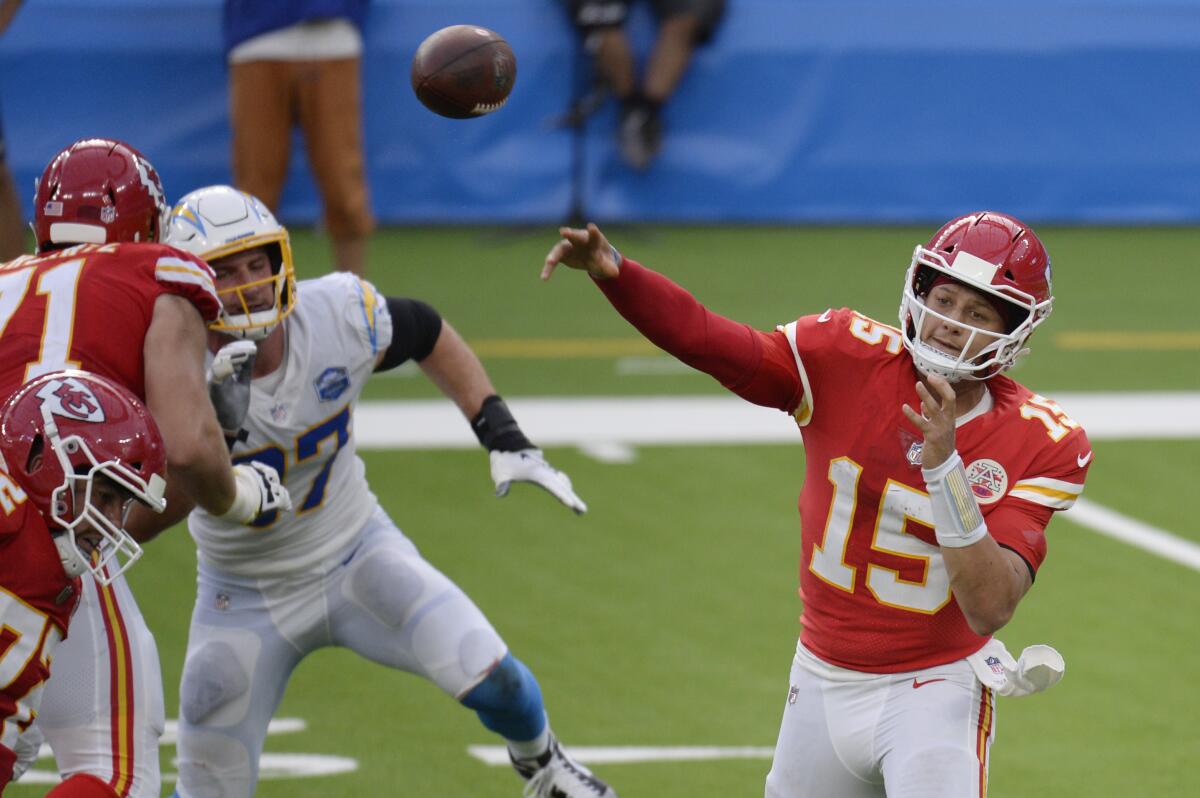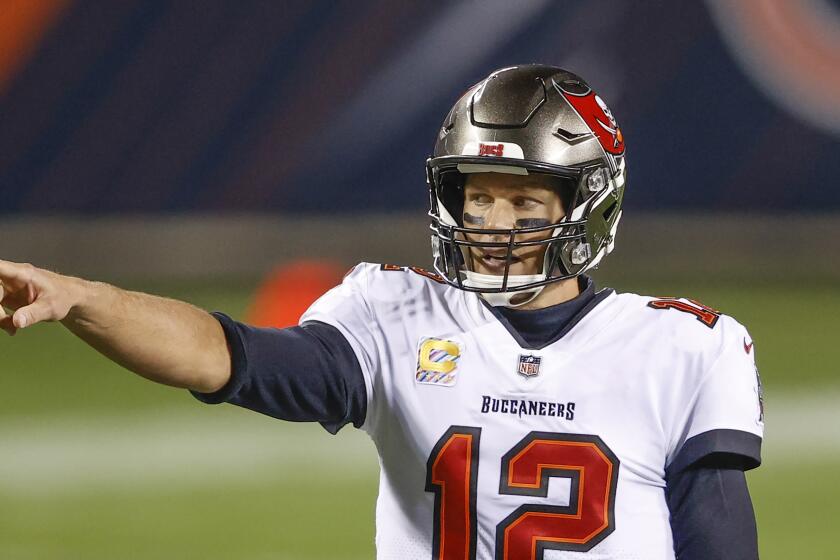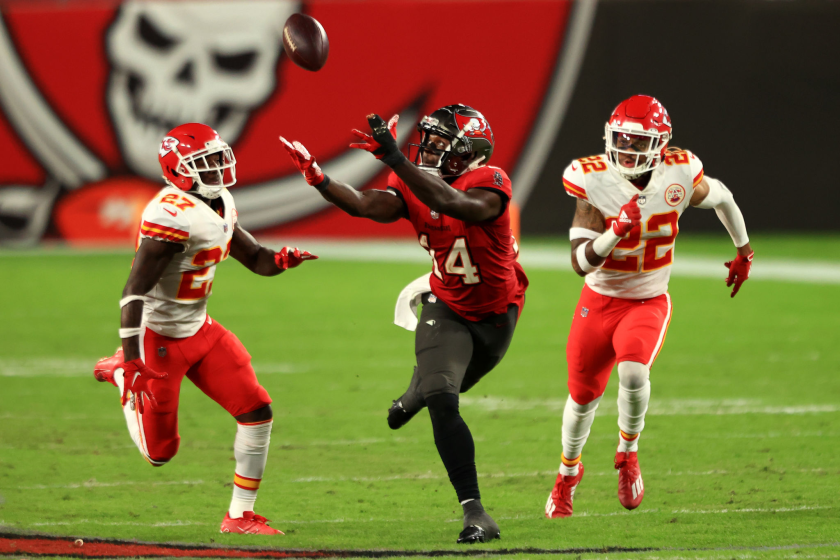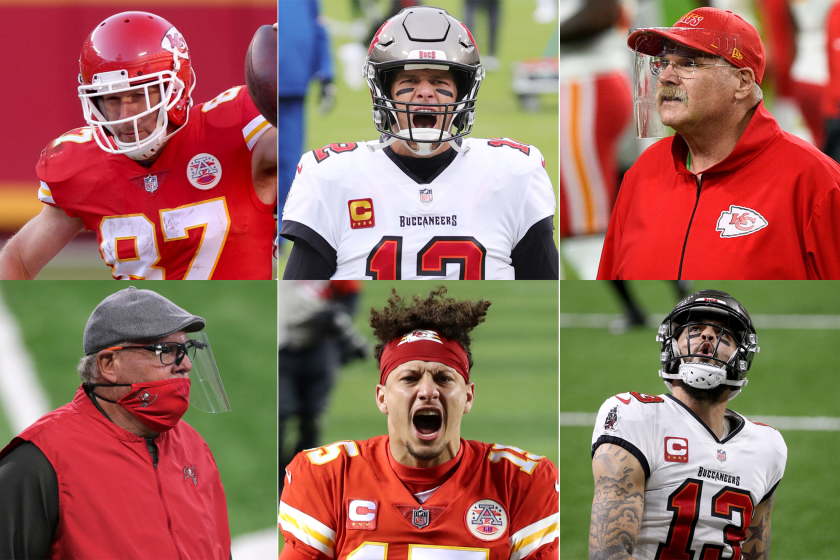Secret to stopping Patrick Mahomes? Bucs might want to copy Chargers’ strategy

- Share via
Everyone has a game plan ahead of their matchup with the Kansas City Chiefs.
Once it’s put into motion, though, the creativity and sheer speed of the reigning Super Bowl champions’ offense typically unravels that strategy.
“I’m not paid to be a defensive coordinator,” Chiefs receiver Tyreek Hill said, chuckling, when asked about how other teams scheme against them. “That’s above my pay grade.”
One defensive coordinator who’s experienced consistent success against the Chiefs is Gus Bradley, who recently joined the Las Vegas Raiders after four seasons with the Chargers.
Chiefs quarterback Patrick Mahomes threw for less than 200 yards three times in 2019, two of them against the Chargers. The Chiefs also lost to the Chargers in the regular season finale in January, though Mahomes rested with the top seed in the AFC already secured.
Times columnist Bill Plaschke often gets Super Bowl predictions wrong, but he has known when Tom Brady will win or lose the big game. Take the Chiefs.
Perhaps no game was as competitive as the teams’ Week 2 matchup, which the Chiefs won, 23-20, via a goal in overtime. And ahead of Super Bowl LV on Sunday, the Chargers’ performance from months ago can offer clues for the Tampa Bay Buccaneers.
Bradley’s scheme rarely sent more than four players to rush the quarterback in his tenure with the Chargers, instead relying on his defensive line, which featured Joey Bosa and Melvin Ingram, to generate pressure.
That gave Bradley options with the other seven defenders to deploy variations of man and zone coverages against the Chiefs’ five receiving options, which included Hill, Mecole Hardman and tight end Travis Kelce.
The Chiefs offense is adept at using the entire length and width of the field with run-pass options, play-action fakes, exotic motions and jet sweeps with receivers, and deep-shot passes, Bradley said. If the coverage was solid coming off the line of scrimmage, it would make Mahomes progress slower after the snap, forcing him to hold the ball. Those extra seconds, Bradley said, would potentially be enough for the defensive line to reach him.
“We’re looking for the quarterback to hitch where we play tight enough coverage for him to hitch and the rush to get there,” Bradley said.
Said Chargers cornerback Casey Hayward: “We have to call the coverage in the backend and slow those guys down and not let them get open fast so the pass rush can get there. They make us better when they get to the quarterback fast and we complement each other. If we hold up guys in the backend, we can help our guys get to the ball.”
That strategy proved successful for much of the game. The defense generated a sack and eight quarterback hits. At the end of the first quarter, the Chargers offense scored first, and the defense limited Mahomes to only two completions in eight attempts. That momentum changed, though.
Breaking down how the Kansas City Chiefs and Tampa Bay Buccaneers will match up on the field in Super Bowl LV on Sunday.
The Chargers lost containment in their rush lanes as the game continued, allowing Mahomes to convert four third-down plays on scrambles. The defense also surrendered a 58-yard touchdown pass from Mahomes to Hill, which tied the score at 17. That might have been a particularly heartbreaking blow to the Chargers because they talked all week about limiting explosive plays.
The Buccaneers played Kansas City in November, losing 27-24. They used a somewhat similar yet different strategy, which yielded some positive results in the second half.
Like Bradley, Todd Bowles’ defense features a stout pass rush with Shaq Barrett, Jason Pierre-Paul and Ndamukong Suh. Bowles’ style is more aggressive than Bradley‘s. The Bucs’ defense blitzed opposing quarterbacks on 39% of drop backs this season, according to Pro Football Reference, the fifth-highest rate in the league. That produced 48 sacks, tied for fourth in the NFL.
But against the Chiefs, who took an early lead against the Buccaneers, Bowles’ defense played a tad more conservative, blitzing on only 17% of Mahomes’ drop backs, according to Pro Football Focus. After surrendering 359 passing yards and two touchdowns in the first half, the defense regrouped, limiting Mahomes to only 103 second-half passing yards and one touchdown, allowing Tom Brady and the offense to mount a comeback.
Willie McGinest, a three-time Super Bowl champion linebacker with the New England Patriots, said the Buccaneers are “perfectly built” to rush four, noting the team’s seven sacks in the playoffs. The Buccaneers also have five interceptions in three postseason games.
McGinest, an analyst for NFL Network, said four-man pressures should be in Bowles’ game plan.
Complete coverage of the Tampa Bay Buccaneers’ 31-9 victory over the Kansas City Chiefs in Super Bowl 2021.
“You have to have that group up front to be able to do that on a consistent basis to drop seven, and against the Chiefs, you have to make sure everyone is covered — some need to be double covered,” McGinest said. “You have to get your hands on the receivers to allow the pressure to get there. If you don’t do that and you let those guys run, it doesn’t matter how great the blitz is or the rush is — the ball is going to come out fast.
“If you run some games up front — some four-man games, some two-man games — with the occasional blitz from [linebacker] Devin White and [linebacker] Lavonte David, I think that will be special.”
Adding to the Bucs strategy should be the Chiefs reshuffling offensive linemen because of injuries, most recently losing starting left tackle Eric Fisher to a torn Achilles tendon in the AFC championship game. Bowles said he still expects them to be prepared for his defense’s pressure regardless of their personnel concerns.
“Those guys won a lot of ball games no matter who’s playing,” he said. “We can’t worry about who’s playing — we just have to slow the team down as a whole.
“Any time you prepare for a team with a lot of weapons, it’s going to be a challenge. All 11 guys on defense are going to have to be on the same page.”
More to Read
Go beyond the scoreboard
Get the latest on L.A.'s teams in the daily Sports Report newsletter.
You may occasionally receive promotional content from the Los Angeles Times.














